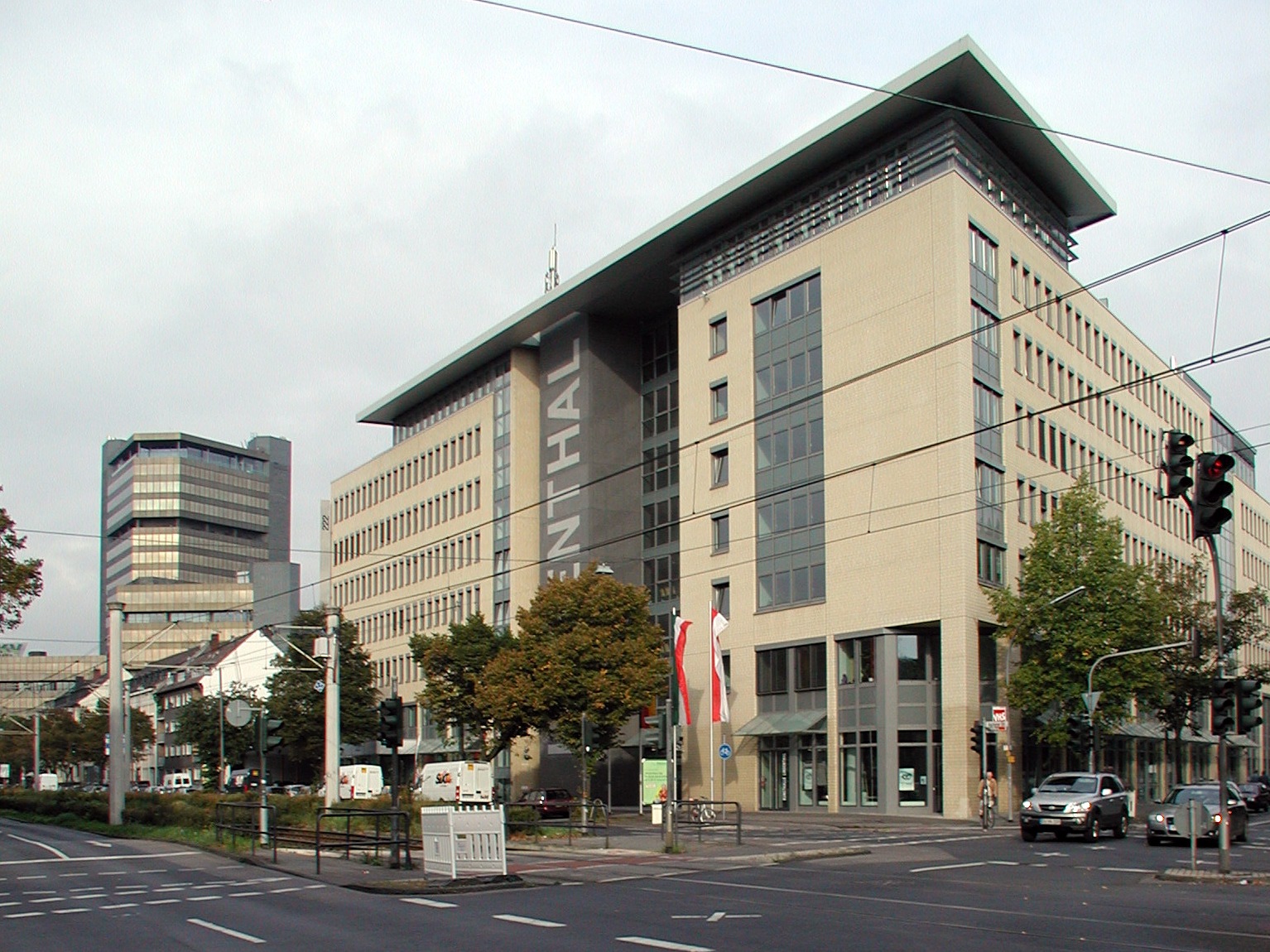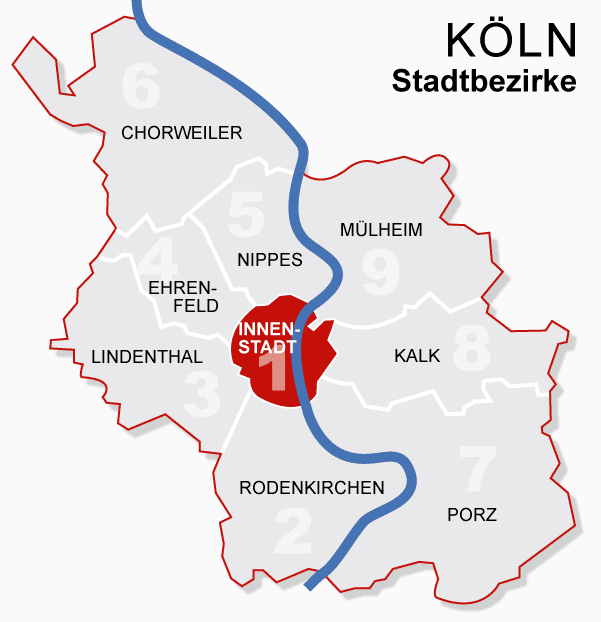|
Junkersdorf
Junkersdorf is a historic village, now quarter 306 of the city of Cologne, Germany, in District Three. Geography Junkersdorf lies to the west of the historic city centre, next to the Köln-West motorway junction where Bundesautobahn 1 and Bundesautobahn 4 intersect. The old road from Cologne to Jülich runs north of the village, and from Cologne to Aachen to the south. History The earliest mention of Junkersdorf is in a charter of Bruno, Archbishop of Cologne, dating from 962. The first reference to a parish church was in 1223. From the early 15th century until 1794 Junkersdorf was an independent lordship within the Electorate of Cologne. During the French period, Junkersdorf became part of nearby Lövenich (now Cologne quarter 308). In 1975 Junkersdorf became part of the City of Cologne. In 1586, during the Cologne War (1583–1588) it was the site of the Junkersdorf Massacre, when marauding soldiers attacked a civilian convoy. In the 1920s a number of Bauhaus residences were ... [...More Info...] [...Related Items...] OR: [Wikipedia] [Google] [Baidu] |
Junkersdorf Wilhelm-von-Capitaine-Str 15 01
Junkersdorf is a historic village, now quarter 306 of the city of Cologne, Germany, in District Three. Geography Junkersdorf lies to the west of the historic city centre, next to the Köln-West motorway junction where Bundesautobahn 1 and Bundesautobahn 4 intersect. The old road from Cologne to Jülich runs north of the village, and from Cologne to Aachen to the south. History The earliest mention of Junkersdorf is in a charter of Bruno, Archbishop of Cologne, dating from 962. The first reference to a parish church was in 1223. From the early 15th century until 1794 Junkersdorf was an independent lordship within the Electorate of Cologne. During the French period, Junkersdorf became part of nearby Lövenich (now Cologne quarter 308). In 1975 Junkersdorf became part of the City of Cologne. In 1586, during the Cologne War (1583–1588) it was the site of the Junkersdorf Massacre, when marauding soldiers attacked a civilian convoy. In the 1920s a number of Bauhaus residences were ... [...More Info...] [...Related Items...] OR: [Wikipedia] [Google] [Baidu] |
Lindenthal, Cologne
Lindenthal ( , ) is a borough of the City of Cologne in Germany. It includes the quarters Braunsfeld, Junkersdorf, Klettenberg, Lindenthal, Lövenich, Müngersdorf, Sülz, Weiden and Widdersdorf. It has about 153,000 inhabitants (as of December 2019) and covers an area of 41.8 square kilometers. Many parts of Lindenthal are dominated by academic and research campuses, primarily linked to the University of Cologne and the German Sport University. The later has a campus at Sportpark Müngersdorf, next to RheinEnergieStadion and the European College of Sport Science. The Cologne University Hospital has a vast campus around the Kerpener Straße. Other institutions include the Max Planck Institutes for Biology of Ageing and Plant Breeding Research. Cologne's Melaten-Friedhof is located on Aachener Straße. History During the Cold War, the headquarters of the I Belgian Corps was located in Junkersdorf. Subdivisions Lindenthal consists of nine ''Stadtteile'' (city quart ... [...More Info...] [...Related Items...] OR: [Wikipedia] [Google] [Baidu] |
Cologne
Cologne ( ; german: Köln ; ksh, Kölle ) is the largest city of the German western States of Germany, state of North Rhine-Westphalia (NRW) and the List of cities in Germany by population, fourth-most populous city of Germany with 1.1 million inhabitants in the city proper and 3.6 million people in the Cologne Bonn Region, urban region. Centered on the left bank of the Rhine, left (west) bank of the Rhine, Cologne is about southeast of NRW's state capital Düsseldorf and northwest of Bonn, the former capital of West Germany. The city's medieval Catholic Cologne Cathedral (), the third-tallest church and tallest cathedral in the world, constructed to house the Shrine of the Three Kings, is a globally recognized landmark and one of the most visited sights and pilgrimage destinations in Europe. The cityscape is further shaped by the Twelve Romanesque churches of Cologne, and Cologne is famous for Eau de Cologne, that has been produced in the city since 1709, and "col ... [...More Info...] [...Related Items...] OR: [Wikipedia] [Google] [Baidu] |
Boroughs And Quarters Of Cologne
Since the last administrative reform in 1975, the City of Cologne is made up of nine Stadtbezirke and 86 Stadtteile. '' Stadtbezirk'' literally translates as city district, which are further subdivided into ''Stadtteile'' (city parts). The Stadtteile of Cologne's old and new town (''Alt-'' and ''Neustadt'') further consist of quarters, known as "''Veedel''" in both Kölsch and most often, the Rhinelandic regiolect, as well. City districts are differentiated of being ''links-'' or ''rechtsrheinisch'' – ''left'' or ''right of the Rhine'', with the old town being left of the Rhine, as are 230,25 km2 (56.8 percent of 405,14 km2 within city limits), while 174,87 km2 (43.2 percent) lie right of the Rhine. In regard to population, Cologne is the largest city in the state of North Rhine-Westphalia and the fourth largest city in Germany. Districts Growth of urban area Since the city's foundation in 38 BC, Cologne grew through numerous extensions and incorporat ... [...More Info...] [...Related Items...] OR: [Wikipedia] [Google] [Baidu] |
Jülich
Jülich (; in old spellings also known as ''Guelich'' or ''Gülich'', nl, Gulik, french: Juliers, Ripuarian: ''Jöllesch'') is a town in the district of Düren, in the federal state of North Rhine-Westphalia, Germany. As a border region between the competing powers in the Lower Rhine and Meuse areas, the town and the Duchy of Jülich played a historic role from the Middle Ages up to the 17th century. Geography Jülich stands in the Rur valley on the banks of the river Rur. The town is bordered by the town of Linnich in the north, the municipality of Titz in the northeast, the municipality of Niederzier in the southeast, the municipality of Inden in the south, and by the municipality of Aldenhoven in the west. Its maximum size is 13.3 km from east to west and 10.9 km from north to south. The highest point in Jülich is in Bourheim, 110 m above sea level (excepting Sophienhöhe, an extensive artificial mountain made up of overburden from a nearby open-pit lignite ... [...More Info...] [...Related Items...] OR: [Wikipedia] [Google] [Baidu] |
Aachen
Aachen ( ; ; Aachen dialect: ''Oche'' ; French and traditional English: Aix-la-Chapelle; or ''Aquisgranum''; nl, Aken ; Polish: Akwizgran) is, with around 249,000 inhabitants, the 13th-largest city in North Rhine-Westphalia, and the 28th-largest city of Germany. It is the westernmost city in Germany, and borders Belgium and the Netherlands to the west, the triborder area. It is located between Maastricht (NL) and Liège (BE) in the west, and Bonn and Cologne in the east. The Wurm River flows through the city, and together with Mönchengladbach, Aachen is the only larger German city in the drainage basin of the Meuse. Aachen is the seat of the City Region Aachen (german: link=yes, Städteregion Aachen). Aachen developed from a Roman settlement and (bath complex), subsequently becoming the preferred medieval Imperial residence of Emperor Charlemagne of the Frankish Empire, and, from 936 to 1531, the place where 31 Holy Roman Emperors were crowned Kings of the Germans. ... [...More Info...] [...Related Items...] OR: [Wikipedia] [Google] [Baidu] |
Electorate Of Cologne
The Electorate of Cologne (german: Kurfürstentum Köln), sometimes referred to as Electoral Cologne (german: Kurköln, links=no), was an ecclesiastical principality of the Holy Roman Empire that existed from the 10th to the early 19th century. It consisted of the Hochstift — the temporal possessions — of the Archbishop of Cologne, and was ruled by him in his capacity as prince-elector. There were only two other ecclesiastical prince-electors in the Empire: the Electorate of Mainz and the Electorate of Trier. The Archbishop-Elector of Cologne was also Arch-chancellor of Italy (one of the three component titular kingdoms of the Holy Roman Empire, the other two being Germany and Burgundy) and, as such, ranked second among all ecclesiastical and secular princes of the Empire, after the Archbishop-Elector of Mainz, and before that of Trier. The capital of the electorate was Cologne. Conflicts with the citizens of Cologne caused the Elector to move to Bonn. The Free Imperial C ... [...More Info...] [...Related Items...] OR: [Wikipedia] [Google] [Baidu] |
French Period
In Northern European historiography, the term French period (french: Période française, german: Franzosenzeit, nl, Franse tijd) refers to the period between 1794 and 1815 during which most of Northern Europe was controlled by Republican or Napoleonic France.Eduard Rothert''Rheinland-Westfalen im Wechsel der Zeiten''.Düsseldorf 1900; Online-Präsentation der Universitätsbibliothek der Heinrich-Heine-Universität Düsseldorf, retrieved 21 March 2011. The exact duration of the period varies by the location concerned. Landschaftsverband Rheinland (LVR), retrieved 18 March 2011. In , the term emerged in the 19th century and developed nationalist connotations. It entered |
Bundesautobahn 4
is an autobahn that crosses Germany in a west–east direction. The western segment has a length of , the part in the east is long. Works to continue the A 4 are in progress, but currently no plans exist to fill the gap completely. The A 4 starts north-west of Aachen, where the Dutch A76 enters Germany. Initially it is 2 lanes each way with no speed limit. From Kreuz Aachen to Düren and from Kerpen to Refrath (between Refrath and Köln-Merheim westbound the hard shoulder is the 3rd lane and only open at peak times) it has 3 lanes each way. Between Kreuz Köln-West and Kreuz Heumar it forms the southern part of the Cologne Beltway ( Kölner Autobahnring). The whole rest of the section between Kreuz Aachen and Kreuz Köln-West has a variable speed limit. Between Merzenich and Elsdorf, there is a speed limit of 130 km/h, that has been imposed in 2017, due to an increase of accidents. Between Kreuz Köln-West and Kreuz Heumar the speed limit is 120 km/h ... [...More Info...] [...Related Items...] OR: [Wikipedia] [Google] [Baidu] |
Bundesautobahn 1
is an autobahn in Germany. It runs from Heiligenhafen in Schleswig-Holstein to Saarbrücken, a distance of , but is incomplete between Cologne and Trier. B 207 continues north from Heiligenhafen to Puttgarden, at the end of the island of Fehmarn, with a ferry to Rødby, Denmark. The part north of Hamburg is part of the ''Vogelfluglinie'' (''Migratory Birds Line'') and may be one day connected via a fixed link to Denmark (see below). The term ''Hansalinie'' ('' Hansa line'') refers to the part from Lübeck (north of Hamburg, thus overlapping the ''Vogelfluglinie'') south to the Ruhr Area (near Dortmund). Overview Schleswig-Holstein In Schleswig-Holstein, the initial section of the A1 (which belongs to the so-called Vogelfluglinie) begins at the junction Heiligenhafen East as a four-lane extension of the B 207 coming from the ferry port Puttgarden on the island of Fehmarn. On the peninsula Wagrien the A 1 briefly runs west, then south, past the East Holstein cities of Ol ... [...More Info...] [...Related Items...] OR: [Wikipedia] [Google] [Baidu] |
Bauhaus
The Staatliches Bauhaus (), commonly known as the Bauhaus (), was a German art school operational from 1919 to 1933 that combined crafts and the fine arts.Oxford Dictionary of Art and Artists (Oxford: Oxford University Press, 4th edn., 2009), , pp. 64–66 The school became famous for its approach to design, which attempted to unify individual artistic vision with the principles of mass production and emphasis on function. The Bauhaus was founded by architect Walter Gropius in Weimar. It was grounded in the idea of creating a Gesamtkunstwerk ("comprehensive artwork") in which all the arts would eventually be brought together. The Bauhaus style later became one of the most influential currents in modern design, modernist architecture, and architectural education. The Bauhaus movement had a profound influence upon subsequent developments in art, architecture, graphic design, interior design, industrial design, and typography. Staff at the Bauhaus included prominent artists ... [...More Info...] [...Related Items...] OR: [Wikipedia] [Google] [Baidu] |









